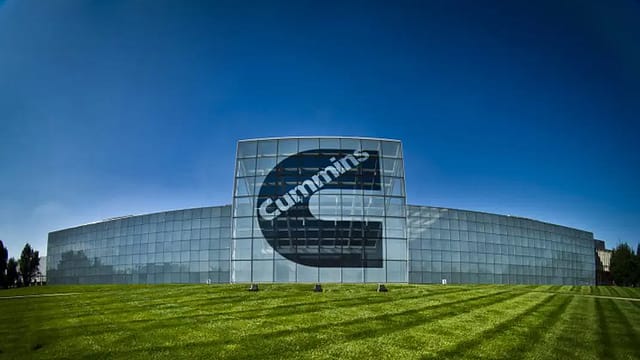Why Cummins is betting big on hydrogen engines in India
ADVERTISEMENT

Cummins Inc., a 106-year-old U.S.-based diesel engine maker, expects India to be among the first few countries to adopt hydrogen internal combustion engines (ICE) for its long-haul trucks.
“India will adopt hydrogen ICE first. That’s why we have started our first facility in India and started production of a 6.7-litre hydrogen ICE engine. Typically, a 6.7-litre engine is used by long-haul and heavy-duty trucks in India,” said Nitin Jirafe, managing director of Tata Cummins, a 50:50 joint venture between Tata Motors and Cummins Inc.
The electrification of diesel-guzzling trucks is not easy, as adding bigger batteries will reduce their payload capacity. That’s where hydrogen could help.
Currently, there are two hydrogen-based technologies: one is fuel-cell where hydrogen is used in liquid or gas form in a fuel cell pack to generate energy and the other is Hydrogen ICE (H2ICE) or hydrogen internal combustion engine.
Tata’s hydrogen ICE trucks powered by Cummins’ engines are already on the roads as part of pilot trials. “Within the next few years, you will see hydrogen powered trucks for sure. But when you’ll see it at scale that is a totally different matter. It depends on our ability to organise partnerships. Cummins can’t do it alone. We need government and OEM partner support. As long as we all push for right policies, it will happen,” said Jane Beaman, vice president – Global On-Highway and Pickup Business, Cummins Inc.
January 2026
Netflix, which has been in India for a decade, has successfully struck a balance between high-class premium content and pricing that attracts a range of customers. Find out how the U.S. streaming giant evolved in India, plus an exclusive interview with CEO Ted Sarandos. Also read about the Best Investments for 2026, and how rising growth and easing inflation will come in handy for finance minister Nirmala Sitharaman as she prepares Budget 2026.
“The additional support that we need is infrastructure, fuelling stations and the development of the whole ecosystem – storage and transportation,” said Beaman, adding that the cost of hydrogen only comes down when there is a significant scale. “So it is a little bit of a chicken and egg situation. It will take time, like as most transformations do. It will unfold over the next several years.”
In March 2024, TCPL GES, a wholly-owned subsidiary of Tata Cummins, started a new manufacturing facility in Jamshedpur to produce hydrogen-based internal combustion engines for medium and heavy commercial vehicles.
Jirafe said both Tata and Cummins are aligned on this product strategy. “We will be manufacturing some of these zero to low-carbon products in Tata Cummins’ step-down joint venture TGES, which was set up in March 2024,” he said. “The Jamshedpur facility is currently producing only hydrogen ICE engines as and when they are required by OEMs. As this is the initial phase of introduction, a lot of trials are happening – either directly with OEMs as well as MNRE (Ministry of New and Renewable Energy) projects. This facility will only produce zero to low-carbon products,” he added.
On the high cost of hydrogen fuel, Jirafe said, “Whenever any new technology or fuel comes, it takes time as initial costs are high. The government is pitching in and supporting some initial projects to take this technology on the roads. As we have more dispensing centres and manufacturing of hydrogen starts in bulk, the cost of hydrogen will also come down. The good thing about this hydrogen engine is it can take both grey and green hydrogen,” he said.
“Decarbonisation is an opportunity as well as an ambition for both Tata Group and Cummins. At Cummins, we have decided to become a zero carbon company by 2050. Cummins has a two-phase decarbonisation strategy: we need to continue to work on diesel engines to improve their efficiency, reduce emissions and make these engines fuel agnostic. While doing that, we are ensuring that we continue to invest a significant amount of money in developing new zero to low-carbon platforms. For example, we have already introduced hydrogen internal combustion engine (ICE) in 2023. Since then, we have made significant progress,” said Jirafe.
While Cummins makes battery cells in the U.S., it has no immediate plans for cell manufacturing in India. “These are capital intensive investments. We need to time the investment along with demand and until the demand is significant across the world. We will pace it according to the demand,” said Beaman.
Beaman, however, said that the Indian market is "hugely significant" for Cummins. “With all the growth that we are seeing in India – the building of expressways, ports and infrastructure. We consider it very much a sweet spot for what Cummins provides, whether that’s with off-highway trucks and construction, which has Cummins' products. It is a significant opportunity for us to grow as India grows.”
The company recently introduced HELM, which stands for higher efficiency, lower emissions and multiple fuels, as part of Cummins’ fuel-agnostic strategy. The basic premise of HELM was to provide a platform that offers technology-agnostic product to customers. “It maintains commonality that supports our sales and service base. The training of technicians and service of products stay consistent for the engine. If you think about the supply chain, the majority of the components are common across different platforms. It supports natural gas, diesel and hydrogen,” said Beaman.
